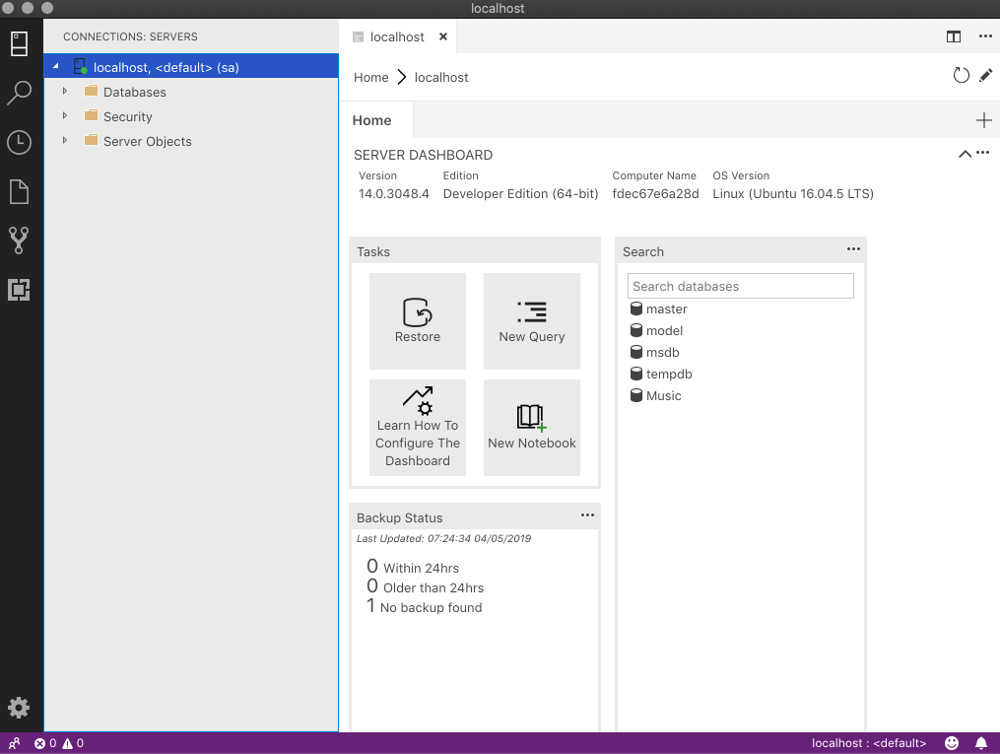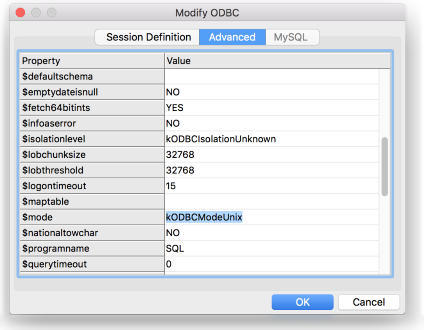Create a Database Environment Mac OS/SQL Developer. Ask Question Asked 5 years, 11 months ago. Active 2 years, 3 months ago. Viewed 1k times 1. Hi I am very new to all of this. I am trying to prototype an function on my local machine. Browse other questions tagged macos mac database. The Overflow Blog Ensuring backwards compatibility in. My employer produces a simple, proof-of-concept HTML5-based SQL client which can be used against any ODBC data source on the web-browser host machine, through the HTML5 WebDB-to-ODBC Bridge we also produce. These components are free, for Mac, Windows, and more. Applicable to many of the other answers here - the Type 1 JDBC-to-ODBC Bridge that most are referring to is the one Sun built in to.
-->- Feb 16, 2018 Setting up Database Servers for Development on Mac OS X Using Docker. Azure CosmosDB SQL or Oracle Database. I'd just install each database directly into my environment. Sometimes I'd face.
- SQL is a relatively simple programming and coding language used to manage data held in a database (or an RDBMS, or relational database management system, to give it its full and fancy name).
- MySQL Database Server is designed for enterprise organizations delivering business critical database applications. It gives corporate developers, DBAs and ISVs an array of new enterprise features.
- Jul 30, 2017 Starting with SQL Server 2017, you can now install SQL Server directly on to a Linux machine. And because macOS is Unix based (and Linux is Unix based), you can run SQL Server for Linux on your Mac. The way to do this is to run SQL Server on Docker. So let’s go ahead and install Docker. Then we’ll download and install SQL Server.
- Stack Exchange network consists of 177 Q&A communities including Stack Overflow, the largest, most trusted online community for developers to learn, share.
By Rick Anderson
The MvcMovieContext object handles the task of connecting to the database and mapping Movie objects to database records. The database context is registered with the Dependency Injection container in the ConfigureServices method in the Startup.cs file:
The ASP.NET Core Configuration system reads the ConnectionString. For local development, it gets the connection string from the appsettings.json file:
The ASP.NET Core Configuration system reads the ConnectionString. For local development, it gets the connection string from the appsettings.json file:
When the app is deployed to a test or production server, an environment variable can be used to set the connection string to a production SQL Server. See Configuration for more information.
SQL Server Express LocalDB
LocalDB is a lightweight version of the SQL Server Express Database Engine that's targeted for program development. LocalDB starts on demand and runs in user mode, so there's no complex configuration. By default, LocalDB database creates .mdf files in the C:/Users/{user} directory.
From the View menu, open SQL Server Object Explorer (SSOX).
Right click on the
Movietable > View Designer
Note the key icon next to ID. By default, EF will make a property named ID the primary key.
Right click on the
Movietable > View Data
SQLite
The SQLite website states:
SQLite is a self-contained, high-reliability, embedded, full-featured, public-domain, SQL database engine. SQLite is the most used database engine in the world.
There are many third party tools you can download to manage and view a SQLite database. The image below is from DB Browser for SQLite. If you have a favorite SQLite tool, leave a comment on what you like about it.
Note
For this tutorial you use the Entity Framework Core migrations feature where possible. Migrations updates the database schema to match changes in the data model. However, migrations can only do the kinds of changes that the EF Core provider supports, and the SQLite provider's capabilities are limited. For example, adding a column is supported, but removing or changing a column is not supported. If a migration is created to remove or change a column, the ef migrations add command succeeds but the ef database update command fails. Due to these limitations, this tutorial doesn't use migrations for SQLite schema changes. Instead, when the schema changes, you drop and re-create the database.
The workaround for the SQLite limitations is to manually write migrations code to perform a table rebuild when something in the table changes. A table rebuild involves:
- Creating a new table.
- Copying data from the old table to the new table.
- Dropping the old table.
- Renaming the new table.
For more information, see the following resources:
Seed the database

Create a new class named SeedData in the Models folder. Replace the generated code with the following:
If there are any movies in the DB, the seed initializer returns and no movies are added.
Add the seed initializer

Replace the contents of Program.cs with the following code:
Test the app
Delete all the records in the DB. You can do this with the delete links in the browser or from SSOX.
Force the app to initialize (call the methods in the
Startupclass) so the seed method runs. To force initialization, IIS Express must be stopped and restarted. You can do this with any of the following approaches:Right click the IIS Express system tray icon in the notification area and tap Exit or Stop Site
- If you were running VS in non-debug mode, press F5 to run in debug mode
- If you were running VS in debug mode, stop the debugger and press F5
Delete all the records in the DB (So the seed method will run). Stop and start the app to seed the database.
The app shows the seeded data.
By Rick Anderson
The MvcMovieContext object handles the task of connecting to the database and mapping Movie objects to database records. The database context is registered with the Dependency Injection container in the ConfigureServices method in the Startup.cs file:
The ASP.NET Core Configuration system reads the ConnectionString. For local development, it gets the connection string from the appsettings.json file:
The ASP.NET Core Configuration system reads the ConnectionString. For local development, it gets the connection string from the appsettings.json file:
When you deploy the app to a test or production server, you can use an environment variable or another approach to set the connection string to a real SQL Server. See Configuration for more information.
SQL Server Express LocalDB
LocalDB is a lightweight version of the SQL Server Express Database Engine that's targeted for program development. LocalDB starts on demand and runs in user mode, so there's no complex configuration. By default, LocalDB database creates .mdf files in the C:/Users/{user} directory.
From the View menu, open SQL Server Object Explorer (SSOX).
Right click on the
Movietable > View Designer
Note the key icon next to ID. By default, EF will make a property named ID the primary key.
Right click on the
Movietable > View Data
SQLite
The SQLite website states:
SQLite is a self-contained, high-reliability, embedded, full-featured, public-domain, SQL database engine. SQLite is the most used database engine in the world.
There are many third party tools you can download to manage and view a SQLite database. The image below is from DB Browser for SQLite. If you have a favorite SQLite tool, leave a comment on what you like about it.
Note
For this tutorial you use the Entity Framework Core migrations feature where possible. Migrations updates the database schema to match changes in the data model. However, migrations can only do the kinds of changes that the EF Core provider supports, and the SQLite provider's capabilities are limited. For example, adding a column is supported, but removing or changing a column is not supported. If a migration is created to remove or change a column, the ef migrations add command succeeds but the ef database update command fails. Due to these limitations, this tutorial doesn't use migrations for SQLite schema changes. Instead, when the schema changes, you drop and re-create the database.
The workaround for the SQLite limitations is to manually write migrations code to perform a table rebuild when something in the table changes. A table rebuild involves:
- Creating a new table.
- Copying data from the old table to the new table.
- Dropping the old table.
- Renaming the new table.
For more information, see the following resources:
Seed the database
Create a new class named SeedData in the Models folder. Replace the generated code with the following:
If there are any movies in the DB, the seed initializer returns and no movies are added.
Add the seed initializer
Replace the contents of Program.cs with the following code:
Test the app
Delete all the records in the DB. You can do this with the delete links in the browser or from SSOX.
Force the app to initialize (call the methods in the
Startupclass) so the seed method runs. To force initialization, IIS Express must be stopped and restarted. You can do this with any of the following approaches:Right click the IIS Express system tray icon in the notification area and tap Exit or Stop Site
- If you were running VS in non-debug mode, press F5 to run in debug mode
- If you were running VS in debug mode, stop the debugger and press F5
Delete all the records in the DB (So the seed method will run). Stop and start the app to seed the database.
The app shows the seeded data.
This certification demonstrates your skills as a database professional, for both on-premises and cloud-based databases.
Job role:Developer

Required exams:
Important:See details
Go to Certification DashboardCertification details
Take two exams
CERTIFICATION EXAM
Sql Database For Macos Environment Free
CERTIFICATION EXAM
Earn the certification
Database For Mac Free Download
EXPERT CERTIFICATION
MCSA: SQL 2016 Database Development